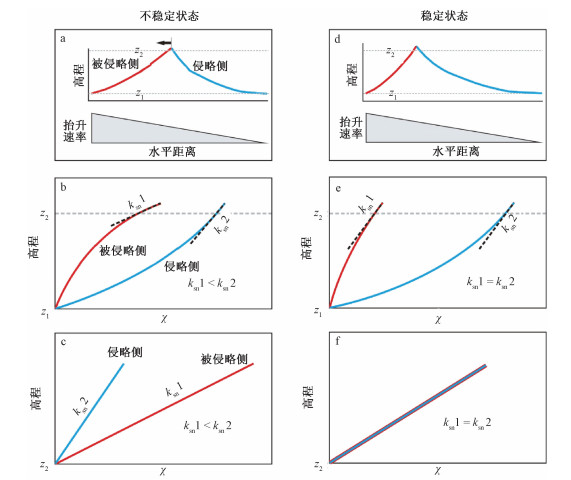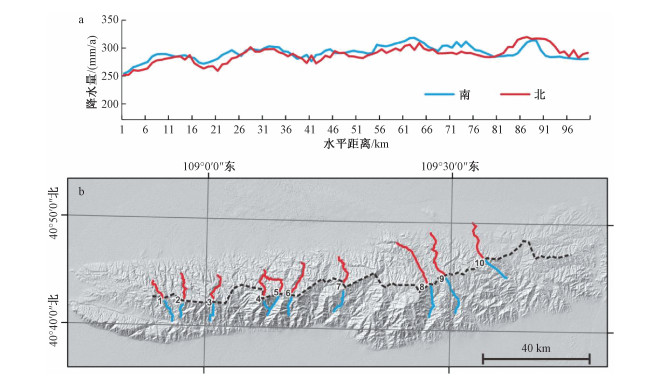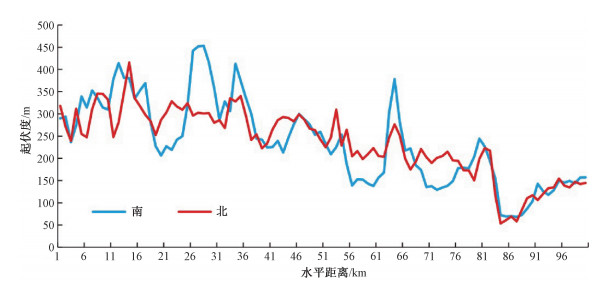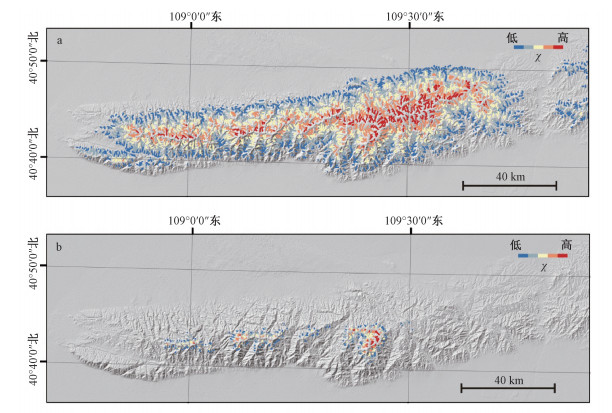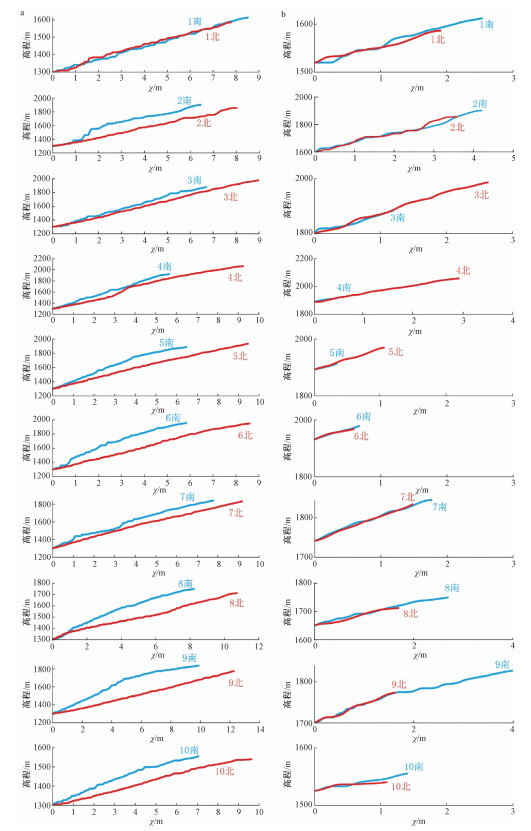Drainage divide stability at Wulashan, northern margin of the Ordos block, China: Evidence from the analysis of χ value
-
摘要: 分水岭的稳定性蕴含着重要的构造和气候信息,但是对于分水岭稳定性的判别标志目前还存在争议,从而导致对某些地区分水岭的稳定性形成不一致的结论。位于鄂尔多斯北缘的乌拉山分水岭稳定性目前存在两种不同的认识:通过两侧流域形态(袭夺弯、裂点等)分析认为乌拉山分水岭正在向北迁移;通过Gilbert参数对比法认为其处于稳定状态。为了检验乌拉山分水岭的稳定性以及上述各种判定方法的可靠性,研究采用χ值对比法对乌拉山分水岭的稳定性进行了研究。χ值分析揭示:如果设置较低的基准线(海拔1300 m),则分水岭南侧顶部χ值小于北侧同一高程的χ值;如果设置较高的基准线(约1800 m),则分水岭两侧的χ值在同一高程基本保持一致。以较高的基准线获得的χ值由于更靠近分水岭而受到块体差异抬升的干扰较小,更能反映分水岭的瞬时稳定性。因此,文章支持乌拉山分水岭处于稳定状态这一认识; 同时文章对判断分水岭稳定性不同方法的局限性进行了讨论。Abstract: The stability of drainage divides carries important tectonic and climatic information. However, there is still no consensus on the criterion for measuring the stability of drainage divides, which may lead to different conclusions. There are two different views on the stability of the divide at the Wulashan horst, northern margin of the Ordos block: The drainage divide is moving northward, according to the comparison of drainage-basin morphology (such as elbows of capture, knick points); The drainage divide remains stable, according to the comparison of Gilbert metrics. In this study, we used the χ-plot method to check both the stability of the Wulashan drainage divide and the reliability of the above methods. The analysis shows that the χ value at the top of the northern side is higher than that at the same elevation of the southern side if a lower baseline was set (1300 m a.s.l.); If a higher baseline (~1800 m a.s.l.) is set, the χ values on both sides of the divide are the same at the same elevation. Because the tilting has relatively less influence, the χ-plot with a higher baseline is more representative of the drainage divide stability. In summary, the result supports the view that the drainage divide at the Wulashan horst is at a steady state. Moreover, we discussed the limitations of the methods in measuring the stability of drainage divides.
-
Key words:
- drainage divide /
- Wulashan horst /
- χ value /
- tilting
-
0. 引言
地球表面形态主要受构造和气候的控制,因此地貌参数被广泛应用于构造和气候过程的重建(Tucker and Slingerland, 1997;Kirby and Whipple, 2001; Kirby et al., 2003;He et al., 2021;Shi et al., 2021)。分水岭的稳定性在现今地貌研究中起重要作用,不仅其本身就是对局部气候、构造条件变化的响应(Castelltort et al., 2012;Beeson et al., 2017;Stikes et al., 2018;Shi et al., 2021;Zhou et al., 2022a),而且分水岭的迁移会造成流域面积的变化从而进一步影响侵蚀速率(Willett et al., 2014;Whipple et al., 2017;Liu et al., 2020;Ye et al., 2022),因此分水岭的稳定性成为近年来构造地貌研究的热点问题之一(Yanites et al., 2013;Vacherat et al., 2018;Struth et al., 2019;Shi et al., 2021;林玲玲等, 2021;Zhou et al., 2022a)。
构造、岩性或气候的扰动均会造成稳定的分水岭发生迁移(Goren et al., 2014; Shi et al., 2021;Zhou et al., 2022a)。比如:在稳定的地貌单元中,山体两侧的岩性和气候条件一致,那么分水岭倾向于向抬升更快的一侧移动,以达到稳定的状态(Willett et al., 2014;Whipple et al., 2017;Shi et al., 2021;Zhou et al., 2022a);稳定的分水岭会向降水量减小或岩性变强的一侧移动(Goren et al., 2014)。因此,分水岭的稳定性常常包含了重要的构造和气候信息。目前分水岭稳定性判断主要有两种方法:χ值对比(Willett et al., 2014);Gilbert参数对比(Whipple et al., 2017; Forte and Whipple, 2018)。χ值是基岩河道下切模型沿河道的面积积分(Perron and Royden, 2013),分水岭两侧的χ值差异被应用于衡量分水岭的稳定性(Willett et al., 2014)。χ值对比的方法通常应用于分水岭两侧的全流域分析(Willett et al., 2014),而Gilbert参数主要包括分水岭两侧小范围内(通常距离分水岭500 m以内)坡度或起伏度(Whipple et al., 2017;Forte and Whipple, 2018)。两种方法可能会得到不同的分水岭稳定性判断(Forte and Whipple, 2018)。Zhou et al.(2022b)综合了χ值对比和Gilbert参数对比两种方法的优势,提出使用高海拔基准面(保持χ值与高程呈现线性相关)的分水岭两侧χ值对比,用来获取分水岭瞬时迁移方向和迁移速率的方法。
位于鄂尔多斯北缘的乌拉山分水岭稳定性目前存在两种不同的认识:通过对比分水岭两侧流域形态,如袭夺弯、裂点等(He et al., 2019)分析认为乌拉山分水岭正在向北迁移;通过对比分水岭两侧近距离范围内的Gilbert参数(He et al., 2021)认为其处于稳定状态。为了检验乌拉山分水岭的稳定性以及上述各种方法的可靠性,文章以河套盆地内正断层为界的乌拉山分水岭为研究对象,采用χ值-高程关系分析的方法(Zhou et al., 2022b)对上述两种不同的观点进行验证,同时也对不同方法的可靠性和局限性进行了分析。
1. 地质背景
鄂尔多斯块体周缘的活动断陷带以正断层和大型历史地震(震级可达M 8.0~8.5)为特征(国家地震局鄂尔多斯周缘断裂系课题组, 1988;邓起东等,1999;李彦宝等,2015;郑文俊等, 2019;Deng and Liao, 1996;Rao et al., 2014, 2015;Xu et al., 2018;图 1)。河套盆地位于鄂尔多斯块体北缘,渐新世开始发育,第四纪时期的平均沉积速率为0.83~1.00 mm/a(国家地震局鄂尔多斯周缘断裂系课题组,1988;李建彪等, 2007;吴利杰等, 2020)。尽管该地区的历史记录较少,但是古地震的研究结果表明,在晚更新世—全新世时期,狼山、色尔腾山、乌拉山以及大青山等地的山前地区的盆地边缘断裂均发生过地表破裂型地震(国家地震局鄂尔多斯周缘断裂系课题组, 1988;冉勇康等, 2003;Ma et al., 1998;Ran et al., 2003;Rao et al., 2016, 2018;He et al., 2018;He et al., 2020)。目前的研究表明,乌拉山山前断裂位于乌拉山南缘,李建彪等(2007)通过年轻地层的变形揭示出100 ka以来的垂直滑动速率为1.38~1.80 mm/a,24 ka以来的垂直滑动速率为0.16~1.92 mm/a,而全新世以来的垂直滑动速率为0.55~0.77 mm/a。He et al. (2020)揭示其50 ka以来的垂向滑动速率约2.20~2.28 mm/a,而全新世以来的速率降为1.12~1.34 mm/a。尽管上述研究揭示出乌拉山山前断裂晚更新世以来的滑动速率有变小的趋势,但也表明其在晚更新世以来具有明显的活动性。而位于乌拉山北缘的断裂活动性较弱,研究认为67 ka以来乌拉山北缘断裂基本处于不活动的状态(陈立春, 2002;陈立春等, 2003)。
近东西走向的乌拉山位于河套盆地中部,北接乌梁素海,南临黄河,西起乌拉特前旗西山咀,向东至包头市昆都仑区,全长大于90 km2(图 1)。乌拉山北麓被乌拉山北缘断裂控制,南麓被乌拉山山前断裂控制。乌拉山除了沿着山谷和山前的地带被新生代沉积物覆盖外,其余地区基岩裸露,包括斜长片麻岩、花岗岩、角闪岩和闪长岩(国家地震局鄂尔多斯周缘断裂系课题组, 1988;图 1)。
2. 研究方法
河流纵剖面记录了基岩岩性、构造应变和气候历史等信息。根据拆离有限模型(Detachment-limited model),基岩河道的侵蚀速率(E)通常用上游流域面积(A)和河道梯度(S)的幂次函数关系公式为:
E=KAmSn (1) 其中,K为河流侵蚀系数,与气候、岩性、沉积物通量和河道几何形态等因素有关;m为流域面积指数,n为河道坡度指数,它们与剥蚀过程的动力特征、盆地的水文状况以及河道形态等因素有关(Howard, 1994;Whipple and Tucker, 1999;Kirby and Whipple, 2012)。基于河流水利侵蚀模型,基岩河道纵剖面通常被描述为河道梯度S与上游流域面积A之间的幂次函数关系,转化后的公式为:
S=(EK)1nA−mn (2) 河流纵向高程剖面(z)可由基准点xb向观测点x在上游方向的积分表示:
z(x)=zb+∫xxbS(x)dx=zb+∫xxb(E(x)K(x))1nA(x)−mndx (3) 其中,zb表示河道基准面x=xb处的高程,dx代表无限微小的沿河水平距离。在侵蚀率(E)和侵蚀系数(K)不变的情况下,公式(3)可以简化为:
z(x)=zb+ksn(A0)−mnχ (4) 其中
ksn=(EK)1n=SAmn (5) χ=∫xxb(A0A(x))mndx (6) ksn为标准河道陡峭指数(Wobus et al., 2006),χ值可看作是根据上游流域面积进行无量纲化的沿河水平距离,A0为参考流域面积(Perron and Royden, 2013)。由公式(4)可知,河道高程z与χ值的斜率等于标准河道陡峭指数ksn。在不同流域的初始高程一致的情况下,分水岭两侧χ值主要受河道陡峭指数的影响,平均ksn较大的一侧所对应的χ值较小。由公式(5)可知,标准河道陡峭指数ksn主要与侵蚀速率E、侵蚀系数K以及河道坡度指数n相关。
χ值-高程剖面图被广泛应用于河流系统平衡分析中,解释大尺度河流夺袭事件,描述水系的动态演化过程(Perron and Royden, 2013;Willett et al., 2014;Beeson et al., 2018;Yang et al., 2020;Hu et al., 2021)。理论上,最高处的χ值-高程梯度(即靠近分水岭处的ksn)是判断分水岭迁移方向的可靠指标(图 2;Zhou et al., 2022b)。随着山体不对称隆升的发生,河道系统变得不稳定,分水岭开始迁移(Willett et al., 2014; Whipple et al., 2017;图 2a)。对于较低基准面高程来说,侵略侧的河道具有较高的χ值,而被侵略侧的河道具有较低的χ值(图 2b)。但如果在较高基准面高程,且只考虑跨分水岭两侧很小的一部分区域时,侵蚀河道的χ值较低,而被侵蚀河道的χ值较高(Zhou et al., 2022b;图 2c)。当分水岭迁移达到新的稳定状态时,分水岭两侧河道对于较低基准面的情况下显示不同的χ值,而对于较高基准面的情况下显示相同的χ值(Zhou et al., 2022b;图 2d、2e、2f)。因此,无论是对称隆起还是不对称隆起的情况下,假设分水岭两侧小范围内的隆升速率一致,那么分水岭的迁移都仅受跨分水岭的地形坡度和ksn的差异控制,这也是Gilbert参数法判断分水岭稳定性的理论基础(Whipple et al., 2017; Forte and Whipple, 2018;Zhou et al., 2022b)。
 图 2 分水岭不稳定与稳定状态的高程- χ值剖面示意图(据Zhou et al., 2022b修改)a—构造掀斜开始时,分水岭处于不稳定状态,抬升速率快的一侧成为被侵略侧;b—虽然被侵略侧的χ值较小,但是其顶部的高程- χ值斜率(与ksn成正比)较低; c—当选择较高基准面时,侵略侧χ值低于被侵略侧;d—在持续的掀斜抬升情形下,分水岭最终达到稳定状态;e—当选择的基准面较低(z1)时,两侧χ值不一致,但是其顶部的高程- χ值斜率保持一致;f—当选择较高的基准面(z2)时, 两侧χ值保持一致。Figure 2. Schematic diagram showing the elevation- χ profiles of the divide both in unsteady and steady states (modified from Zhou et al., 2022b)(a) The longitudinal profiles of the two rivers are in an unsteady state when the tilting begins and the higher uplift side is the victim side; (b) Although the victim side has a lower χ value, its top elevation- χ slope, which is proportional to the ksn, is lower; (c) When we choose a higher base level, the χ value in the aggressor is lower than that in the victim. (d) When the tilting continues long enough, the drainage divide achieves a steady state; (e) When we choose a lower base level (z1), the two sides across the divide have different χ values, but the same top elevation- χ slope; (f) When we choose a higher base level (z2), the two sides across the divide have the same χ value.
图 2 分水岭不稳定与稳定状态的高程- χ值剖面示意图(据Zhou et al., 2022b修改)a—构造掀斜开始时,分水岭处于不稳定状态,抬升速率快的一侧成为被侵略侧;b—虽然被侵略侧的χ值较小,但是其顶部的高程- χ值斜率(与ksn成正比)较低; c—当选择较高基准面时,侵略侧χ值低于被侵略侧;d—在持续的掀斜抬升情形下,分水岭最终达到稳定状态;e—当选择的基准面较低(z1)时,两侧χ值不一致,但是其顶部的高程- χ值斜率保持一致;f—当选择较高的基准面(z2)时, 两侧χ值保持一致。Figure 2. Schematic diagram showing the elevation- χ profiles of the divide both in unsteady and steady states (modified from Zhou et al., 2022b)(a) The longitudinal profiles of the two rivers are in an unsteady state when the tilting begins and the higher uplift side is the victim side; (b) Although the victim side has a lower χ value, its top elevation- χ slope, which is proportional to the ksn, is lower; (c) When we choose a higher base level, the χ value in the aggressor is lower than that in the victim. (d) When the tilting continues long enough, the drainage divide achieves a steady state; (e) When we choose a lower base level (z1), the two sides across the divide have different χ values, but the same top elevation- χ slope; (f) When we choose a higher base level (z2), the two sides across the divide have the same χ value.文章利用ALOS DEM(12.5 m分辨率)对乌拉山分水岭附近的水系进行了χ值分析,得到了最小流域面积为105 m2的χ值图(图 3)。文章采用的投影坐标系为WGS_ 1984_ UTM_ zone_ 49N。基于MATLAB程序的TAK工具包(Forte and Whipple, 2019)和TopoToolbox工具包(Schwanghart and Scherler, 2014),首先提取乌拉山的流域信息,沿分水岭两侧成对选取河道,分别计算基准面高程为1300 m和1800 m(图 3)的流域稳定性指标χ值,部分分水岭两侧河道高程未达到1800 m的选取邻近分水岭的适当高程。用于衡量流域稳定性的其他指标,如起伏度(Relief)和降水量,则在ArcGIS中计算得出。
3. 结果与讨论
乌拉山的山体主要为片麻岩和花岗岩,岩石的可蚀度(Erodibility)较为一致。另外乌拉山地区的年平均降水量区域差异较小(图 4a)。综合岩性和降水资料,文章认为乌拉山分水岭两侧流域的侵蚀系数(K)较为均一。文章沿乌拉山分水岭南北两侧均匀地选取10对河道进行分析,河道位置如图 4b所示。河道走向基本垂直于分水岭,在相同基准高程的情况下,南侧河道明显要短于北侧河道(图 4b)。然后对上述10对河道进行不同高程基准面的χ值-高程对比(图 5)。在基准面为海拔1300 m的情况下,分水岭南侧河道的χ值大多小于北侧河道。而在基准面为海拔1800 m时,分水岭两侧河道的χ值基本一致(图 5)。基准面为约1800 m时所得到的χ值更能反映现阶段分水岭迁移的瞬时状态,因此χ值分析结果表明乌拉山分水岭基本保持稳定状态。根据DEM数据,此研究通过ArcGIS软件提取了分水岭两侧300 m内地形起伏度(图 6)。根据图 6可以看出,分水岭两侧的起伏度基本一致,从另一个角度说明乌拉山的分水岭保持稳定状态(Whipple et al., 2017; Forte and Whipple, 2018),与文中的χ值对比分析结果一致。
 图 4 乌拉山分水岭两侧河道分布a—分水岭两侧(500 m范围内)降水量对比(1970—2000年平均降水量;数据来源于http://worldclim.org);b—河道分布(编号1—10)Figure 4. The distribution of river channels on both sides of the main drainage divide of the Wulashan horst(a) Comparison of precipitation on both sides (within 500 m) of the main divide of the Wulashan horst. (Annual average precipitation data (1970~2000) from http://worldclim.org); (b) Channel distribution (Numbers 1-10)
图 4 乌拉山分水岭两侧河道分布a—分水岭两侧(500 m范围内)降水量对比(1970—2000年平均降水量;数据来源于http://worldclim.org);b—河道分布(编号1—10)Figure 4. The distribution of river channels on both sides of the main drainage divide of the Wulashan horst(a) Comparison of precipitation on both sides (within 500 m) of the main divide of the Wulashan horst. (Annual average precipitation data (1970~2000) from http://worldclim.org); (b) Channel distribution (Numbers 1-10) 图 5 乌拉山分水岭两侧河道χ值-高程分布图(河道位置见图 4)a—较低基准面的χ值-高程分布图;b—较高基准面χ值-高程分布图Figure 5. Distribution map of river elevation- χ values on both sides of the main drainage divide of the Wulashan horst(The distribution of the river channels is shown in Fig. 4)(a) The elevation- χ plots with lower base levels; (b) The elevation- χ plots of the corresponding river with higher base levels
图 5 乌拉山分水岭两侧河道χ值-高程分布图(河道位置见图 4)a—较低基准面的χ值-高程分布图;b—较高基准面χ值-高程分布图Figure 5. Distribution map of river elevation- χ values on both sides of the main drainage divide of the Wulashan horst(The distribution of the river channels is shown in Fig. 4)(a) The elevation- χ plots with lower base levels; (b) The elevation- χ plots of the corresponding river with higher base levels在水系演化过程中,分水岭的稳定性决定于其两侧流域系统受到的内外营力(包括岩性、降水、构造等)的差异(Zhou et al., 2022a)。He et al. (2019)根据高程-面积积分(HI)、河道宽度与深度比(VF)、标准河道陡峭指数(ksn)等参数分析,认为乌拉山南侧的侵蚀速率大于北侧。但是由于乌拉山南侧流域的抬升速率大于北侧,所以南侧较大的侵蚀速率并不一定会造成分水岭向北侧迁移,而是要综合考虑抬升和剥蚀的共同影响(Zhou et al., 2022a;图 2)。根据研究对于乌拉山分水岭两侧河道χ值计算的结果(图 5)可知:当选择较低基准面时,乌拉山南侧流域的χ值(在同一高程)小于北侧,即南侧流域平均ksn大于北侧;当选择的基准面高程足够高,乌拉山南侧流域的χ值(在同一高程)与北侧基本一致,即南侧小范围内的平均ksn等于北侧。显然当基准面高程较高时,两侧河道均位于分水岭两侧较小范围内(图 3b),可以避免或减少山体两侧的不对称抬升对分水岭稳定性判断的干扰。选用较高基准面的χ值对比更能反映分水岭两侧小范围内的侵蚀速率差异,而且能够最大程度地减小差异抬升对结果的影响,从而更能反映分水岭的瞬时稳定性(图 2)。研究中的χ值对比分析显示乌拉山的分水岭保持稳定状态,现今并未向北迁移。这一认识与He et al.(2021)通过Gilbert参数对比法获得的乌拉山分水岭稳定性判断一致,也与分水岭两侧300 m内提取的起伏度差异的结果一致(图 6)。另外,乌拉山分水岭现今保持稳定状态,表明乌拉山的构造、气候和岩性在晚新生代以来保持较稳定的状态(Zhou et al., 2022a)。结合在中条山和五台山等地区的已有工作成果(Su et al., 2020; Shi et al., 2021; Zhou et al., 2022a),分水岭稳定性研究将对鄂尔多斯块体周围地堑系的形成过程具有重要的约束。
上述研究结果表明,当采用χ值对比或者河道宽度与深度比(VF)、标准河道陡峭指数(ksn)等方法判断分水岭稳定性时,要尽可能选择距离分水岭较近的河道段。这样既可以避免两侧河道内部属性(包括岩性、降水等)可能存在的差异,也可以避免两侧流域抬升速率的差异。上述两种因素都会干扰分水岭稳定性的判断。而Gilbert参数对比法由于只对比了分水岭两侧源头斜坡(headwater hillslope)的坡度等参数(Whipple et al., 2017;Forte and Whipple, 2018),因此可以获得更可靠的分水岭瞬时稳定性。但是在使用Gilbert参数对比法进行分水岭稳定性判断时,也要考虑分水岭两侧几百米范围内侵蚀系数(受岩性、岩层产状、降水量等因素影响)可能存在的差异。
4. 结论
文章通过采用χ值对比法以及分水岭两侧300 m内的起伏度对比,揭示乌拉山分水岭处于稳定状态。这一认识与使用Gilbert参数对比法进行分水岭稳定性判断结果一致。分水岭两侧流域内部属性(包括岩性、降水等)及构造差异(如掀斜抬升)都会干扰分水岭稳定性的判断。当采用χ值对比、标准河道陡峭指数(ksn)等方法判断分水岭稳定性时,要尽可能选择距离分水岭较近的流域,以避免上述两种因素存在差异。
致谢: 感谢叶轶佳、卞爽、曾洵、高帆在本研究中提供的帮助以及对稿件提出的修改建议。责任编辑:吴芳 -
图 2 分水岭不稳定与稳定状态的高程- χ值剖面示意图(据Zhou et al., 2022b修改)
a—构造掀斜开始时,分水岭处于不稳定状态,抬升速率快的一侧成为被侵略侧;b—虽然被侵略侧的χ值较小,但是其顶部的高程- χ值斜率(与ksn成正比)较低; c—当选择较高基准面时,侵略侧χ值低于被侵略侧;d—在持续的掀斜抬升情形下,分水岭最终达到稳定状态;e—当选择的基准面较低(z1)时,两侧χ值不一致,但是其顶部的高程- χ值斜率保持一致;f—当选择较高的基准面(z2)时, 两侧χ值保持一致。
Figure 2. Schematic diagram showing the elevation- χ profiles of the divide both in unsteady and steady states (modified from Zhou et al., 2022b)
(a) The longitudinal profiles of the two rivers are in an unsteady state when the tilting begins and the higher uplift side is the victim side; (b) Although the victim side has a lower χ value, its top elevation- χ slope, which is proportional to the ksn, is lower; (c) When we choose a higher base level, the χ value in the aggressor is lower than that in the victim. (d) When the tilting continues long enough, the drainage divide achieves a steady state; (e) When we choose a lower base level (z1), the two sides across the divide have different χ values, but the same top elevation- χ slope; (f) When we choose a higher base level (z2), the two sides across the divide have the same χ value.
图 4 乌拉山分水岭两侧河道分布
a—分水岭两侧(500 m范围内)降水量对比(1970—2000年平均降水量;数据来源于http://worldclim.org);b—河道分布(编号1—10)
Figure 4. The distribution of river channels on both sides of the main drainage divide of the Wulashan horst
(a) Comparison of precipitation on both sides (within 500 m) of the main divide of the Wulashan horst. (Annual average precipitation data (1970~2000) from http://worldclim.org); (b) Channel distribution (Numbers 1-10)
图 5 乌拉山分水岭两侧河道χ值-高程分布图(河道位置见图 4)
a—较低基准面的χ值-高程分布图;b—较高基准面χ值-高程分布图
Figure 5. Distribution map of river elevation- χ values on both sides of the main drainage divide of the Wulashan horst(The distribution of the river channels is shown in Fig. 4)
(a) The elevation- χ plots with lower base levels; (b) The elevation- χ plots of the corresponding river with higher base levels
-
CASTELLTORT S, GOREN L, WILLETT S D, et al., 2012. River drainage patterns in the New Zealand Alps primarily controlled by plate tectonic strain[J]. Nature Geoscience, 5(10): 744-748. doi: 10.1038/ngeo1582 CHEN L C, 2002. Paleoearthquakes, the law of strong earthquake recurrence and potential sites for the occurrence of future strong earthquakes in the Hetao fault-depression zone[D]. Beijing: Institute of Geology, China Earthquake Administration. (in Chinese with English abstract) DENG Q D, CHENG S P, MIN W, et al., 1999. Discussion on Cenozoic tectonics and dynamics of Ordos block[J]. Journal of Geomechanics, 5(3): 13-21. (in Chinese with English abstract) DENG Q D, LIAO Y H, 1996. Paleoseismology along the range-front fault of Helan Mountains, north central China[J]. Journal of Geophysical Research: Solid Earth, 101(B3): 5873-5893. doi: 10.1029/95JB01814 FORTE A M, WHIPPLE K X, 2018. Criteria and tools for determining drainage divide stability[J]. Earth and Planetary Science Letters, 493: 102-117. doi: 10.1016/j.epsl.2018.04.026 FORTE A M, WHIPPLE K X, 2019. Short communication: The Topographic Analysis Kit (TAK) for TopoToolbox[J]. Earth Surface Dynamics, 7(1): 87-95. doi: 10.5194/esurf-7-87-2019 GILBERT G K, 1877. Geology of the Henry mountains[R]. Washington: Government Printing Office. GOREN L, WILLETT S D, HERMAN F, et al., 2014. Coupled numerical-analytical approach to landscape evolution modeling[J]. Earth Surface Processes and Landforms, 39(4): 522-545. doi: 10.1002/esp.3514 HE C Q, CHENG Y L, RAO G, et al., 2018. Geomorphological signatures of the evolution of active normal faults along the Langshan Mountains, North China[J]. Geodinamica acta, 30(1): 163-182. doi: 10.1080/09853111.2018.1458935 HE C Q, RAO G, YANG R, et al., 2019. Divide migration in response to asymmetric uplift: Insights from the Wula Shan horst, North China[J]. Geomorphology, 339: 44-57. doi: 10.1016/j.geomorph.2019.04.024 HE C Q, YANG C J, TUROWSKI J M, et al., 2021. Constraining tectonic uplift and advection from the main drainage divide of a mountain belt[J]. Nature communications, 12(1): 544. doi: 10.1038/s41467-020-20748-2 HE Z T, MA B Q, HAO Y J, et al., 2020. Surface rupture geomorphology and vertical slip rates constrained by terraces along the Wulashan piedmont fault in the Hetao Basin, China[J]. Geomorphology, 358: 107116. doi: 10.1016/j.geomorph.2020.107116 BEESON H W, MCCOY S W, KEEN-ZEBERT A, 2017. Geometric disequilibrium of river basins produces long-lived transient landscapes[J]. Earth and Planetary Science Letters, 475: 34-43. doi: 10.1016/j.epsl.2017.07.010 HOWARD A D, 1994. A detachment-limited model of drainage basin evolution[J]. Water resources research, 30(7), 2261-2285. doi: 10.1029/94WR00757 KIRBY E, WHIPPLE K, 2001. Quantifying differential rock-uplift rates via stream profile analysis[J]. Geology, 29(5): 415-418. doi: 10.1130/0091-7613(2001)029<0415:QDRURV>2.0.CO;2 KIRBY E, WHIPPLE K X, 2012. Expression of active tectonics in erosional landscapes[J]. Journal of Structural Geology, 44: 54-75. doi: 10.1016/j.jsg.2012.07.009 KIRBY J R, PARRILA R K, PFEIFFER S L, 2003. Naming speed and phonological awareness as predictors of reading development[J]. Journal of Educational Psychology, 95(3): 453-464. doi: 10.1037/0022-0663.95.3.453 LI J B, RAN Y K, GUO W S, 2007. Division of Quaternary beds and environment evolution in Hubao basin in China[J]. Quaternary Sciences, 27(4): 632-644. (in Chinese with English abstract) LI Y B, RAN Y K, CHEN L C, et al., 2015. The latest surface rupture events on the major active faults and great historical earthquakes in Hetao fault-depression zone[J]. Seismology and Geology, 37(1): 110-125. (in Chinese with English abstract) LIN L L, LI X M, ZHANG H P, et al., 2021. River capture and divide migration of the Zhuozishan area in the northwestern margin of the Ordos Block[J]. Journal of Geomechanics, 27 (2): 294-303. (in Chinese with English abstract) LIU Y D, TAN X B, YE Y J, et al., 2020. Role of erosion in creating thrust recesses in a critical-taper wedge: An example from Eastern Tibet[J]. Earth and Planetary Science Letters, 540: 116270. doi: 10.1016/j.epsl.2020.116270 PERRON J T, ROYDEN L, 2013. An integral approach to bedrock river profile analysis[J]. Earth Surface Processes and Landforms, 38(6): 570-576. doi: 10.1002/esp.3302 RAN Y K, CHEN L C, YANG X P, et al., 2003. Recurrence characteristics of late Quaternary strong earthquakes on the major active faults along the northern border of Ordos Block[J]. Science in China (Series D): Earth Sciences, 46(2): 189-200. . (in Chinese with English abstract) RAO G, LIN A M, YAN B, et al., 2014. Tectonic activity and structural features of active intracontinental normal faults in the Weihe Graben, central China[J]. Tectonophysics, 636: 270-285. doi: 10.1016/j.tecto.2014.08.019 RAO G, LIN A M, YAN B, 2015. Paleoseismic study on active normal faults in the southeastern Weihe Graben, central China[J]. Journal of Asian Earth Sciences, 114: 212-225. doi: 10.1016/j.jseaes.2015.04.031 RAO G, CHEN P, HU J M, et al., 2016. Timing of Holocene paleo-earthquakes along the Langshan Piedmont Fault in the western Hetao Graben, North China: Implications for seismic risk[J]. Tectonophysics, 677-678: 115-124. doi: 10.1016/j.tecto.2016.03.035 RAO G, HE C Q, CHENG Y L, et al., 2018. Active normal faulting along the Langshan Piedmont Fault, North China: Implications for slip partitioning in the western Hetao Graben[J]. The Journal of Geology, 126(1): 99-118. doi: 10.1086/694748 SCHWANGHART W, SCHERLER D, 2014. Short Communication: TopoToolbox 2-MATLAB-based software for topographic analysis and modeling in Earth surface sciences[J]. Earth Surface Dynamics, 2 (1): 1-7. doi: 10.5194/esurf-2-1-2014 SHI F, TAN X B, ZHOU C, et al., 2021. Impact of asymmetric uplift on mountain asymmetry: Analytical solution, numerical modeling, and natural examples[J]. Geomorphology, 389: 107862. doi: 10.1016/j.geomorph.2021.107862 SU Q, WANG X Y, LU H Y, et al., 2020. Dynamic Divide Migration as a Response to Asymmetric Uplift: An Example from the Zhongtiao Shan, North China[J]. Remote Sensing, 12(24): 4188. doi: 10.3390/rs12244188 STOKES M F, GOLDBERG S L, PERRON J T, 2018. Ongoing river capture in the Amazon[J]. Geophysical Research Letters, 45(11): 5545-5552. doi: 10.1029/2018GL078129 STRUTH L, GARCIA-CASTELLANOS D, VIAPLANA-MUZAS M, et al., 2019. Drainage network dynamics and knickpoint evolution in the Ebro and Duero basins: From endorheism to exorheism[J]. Geomorphology, 327: 554-571. doi: 10.1016/j.geomorph.2018.11.033 The Research Group on Active Fault System around Ordos Massif, State Seismological Bureau (RGAFSO), 1988. Active fault system Around Ordos Massif[M], Beijing, China: Seismological Press: 1-335. (in Chinese) TUCKER G E, SLINGERLAND R, 1997. Drainage basin responses to climate change[J]. Water Resources Research, 33(8): 2031-2047. doi: 10.1029/97WR00409 VACHERAT A, BONNET S, MOUTHEREAU F, 2018. Drainage reorganization and divide migration induced by the excavation of the Ebro basin (NE Spain)[J]. Earth Surface Dynamics, 6(2): 369-387. doi: 10.5194/esurf-6-369-2018 WHIPPLE K X, FORTE A M, DIBIASE R A, et al., 2017. Timescales of landscape response to divide migration and drainage capture: Implications for the role of divide mobility in landscape evolution[J]. Journal of Geophysical Research: Earth Surface, 122(1): 248-273. doi: 10.1002/2016JF003973 WHIPPLE K X, TUCKER G E, 1999. Dynamics of the stream-power river incision model: Implications for height limits of mountain ranges, landscape response timescales, and research needs[J]. Journal of Geophysical Research: Solid Earth, 104(B8): 17661-17674. doi: 10.1029/1999JB900120 WILLETT S D, MCCOY S W, PERRON J T, et al., 2014. Dynamic reorganization of river basins[J]. Science, 343(6175): 1248765. doi: 10.1126/science.1248765 WOBUS C, WHIPPLE K X, KIRBY E, et al., 2006. Tectonics from topography: Procedures, promise, and pitfalls[M]//WILLETT S D, HOVIUS N, BRANDON M T, et al. Tectonics, Climate, and Landscape Evolution. Boulder: geological society of America, 55-74. WU L J, SHI J S, ZHANG Y, L et al., 2020. Ostracod characteristics of the eastern Hetao Basin and its sedimentary environmental significance during the Middle and Late Quaternary. Journal of Geomechanics, 26 (1): 125-134. (in Chinese with English abstract) XU Y R, HE H L, DENG Q D, et al., 2018. The CE 1303 Hongdong earthquake and the Huoshan Piedmont fault, Shanxi graben: Implications for magnitude limits of normal fault earthquakes[J]. Journal of Geophysical Research: Solid Earth, 123(4): 3098-3121. doi: 10.1002/2017JB014928 YANITES B J, EHLERS T A, BECKER J K, et al., 2013. High magnitude and rapid incision from river capture: Rhine River, Switzerland[J]. Journal of Geophysical Research: Earth Surface, 118(2): 1060-1084. doi: 10.1002/jgrf.20056 ZHENG W J, ZHANG P Z, YUAN D Y, et al., 2019. Basic characteristics of active tectonics and associated geodynamic processes in continental China[J]. Journal of Geomechanics, 25(5): 699-721. (in Chinese with English abstract) ZHOU C, TAN X B, LIU Y D, et al., 2022a. A cross-divide contrast index (C) for assessing controls on the main drainage divide stability of a mountain belt[J]. Geomorphology, 398: 108071. doi: 10.1016/j.geomorph.2021.108071 ZHOU C, TAN X B, LIU Y D, et al., 2022b. Ongoing Westward Migration of Drainage Divides in Eastern Tibet, Quantified from Topographic Analysis[J]. Geomorphology, 402: 108123. doi: 10.1016/j.geomorph.2022.108123 陈立春, 2002. 河套断陷带的古地震、强震复发规律和未来可能强震地点[D]. 北京: 中国地震局地质研究所. 邓起东, 程绍平, 闵伟, 等, 1999. 鄂尔多斯块体新生代构造活动和动力学的讨论[J]. 地质力学学报, 5(3): 13-21. doi: 10.3969/j.issn.1006-6616.1999.03.003 国家地震局《鄂尔多斯周缘断裂系》课题组, 1988. 鄂尔多斯周缘活动断裂系[M]. 北京: 地震出版社: 1-335. 李建彪, 冉勇康, 郭文生, 2007. 呼包盆地第四纪地层与环境演化[J]. 第四纪研究, 27(4): 632-644. doi: 10.3321/j.issn:1001-7410.2007.04.020 李彦宝, 冉勇康, 陈立春, 等, 2015. 河套断陷带主要活动断裂最新地表破裂事件与历史大地震[J]. 地震地质, 37(1): 110-125. doi: 10.3969/j.issn.0253-4967.2015.01.009 林玲玲, 李雪梅, 张会平, 等, 2021. 鄂尔多斯西北缘桌子山地区河流袭夺和分水岭迁移研究[J]. 地质力学学报, 27(2): 294-303. doi: 10.12090/j.issn.1006-6616.2021.27.02.027 冉勇康, 陈立春, 杨晓平, 等, 2003. 鄂尔多斯地块北缘主要活动断裂晚第四纪强震复发特征[J]. 中国科学(D辑), 33(S1): 135-143. https://www.cnki.com.cn/Article/CJFDTOTAL-JDXK2003S1014.htm 吴利杰, 石建省, 张翼龙, 等, 2020. 河套盆地东部第四纪中晚期介形类特征及其沉积环境意义[J]. 地质力学学报, 26(1): 125-134. doi: 10.12090/j.issn.1006-6616.2020.26.01.013 郑文俊, 张培震, 袁道阳, 等, 2019. 中国大陆活动构造基本特征及其对区域动力过程的控制[J]. 地质力学学报, 25(5): 699-721. doi: 10.12090/j.issn.1006-6616.2019.25.05.062 期刊类型引用(0)
其他类型引用(1)
-






 下载:
下载:


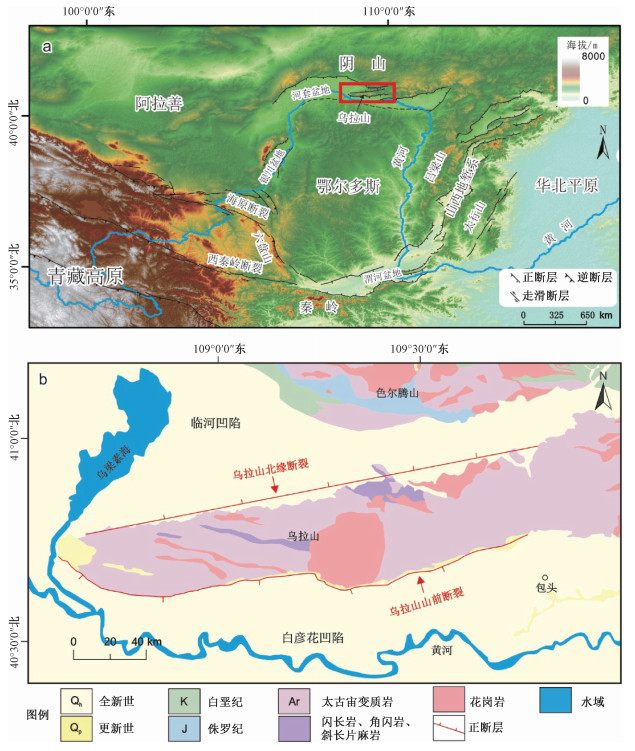
 下载:
下载:
